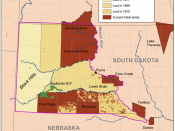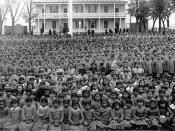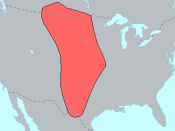Bailey P. 590-606: The Great West and the Agriculture Revolution (1865-1896)
1890: the Great West made into four states/territories of Utah, Arizona, New Mexico, and "Indian Territory," or Oklahoma
Many pioneers sought the land
Land transformed rapidly
The Clash of Cultures on the Plains
Native Americans vs. white pioneers
Cheyenne and Sioux changed into nomadic traders and deadly buffalo hunters
White intruders gave deadly diseases to Native Americans, hunted buffalo
Conflicts between two intensified
Fed. Gov. tried to pacify Plains Indians with treaties at Ft Laramie 1851 and Ft Atkinson 1853, marked beginning of reservation system in West
Each tribe would have boundaries, attempt to separate
1860s: Fed. Gov. herded Indians into smaller confines, "Great Sioux Reservation" in Dakota and Indian Territory in Oklahoma, many southern Plains tribes forced
Indians surrendered land if left alone and provided w/ food, clothing, etc
Federal Indian agents corrupt, gave surrendered Indians poor supplies
Army troops mostly immigrants, 1/5 black (called Buffalo Soldiers by Indians)
Receding Native Population
Sand Creek, Colorado, 1864: whites massacre Indians
1866: Fetterman massacre in Wyoming, not a single white survivor, protect Bozeman trail
Ft Laramie Treaty (1868), gov abandons Bozeman trail
Indians wipe out Custer & army when they invade Sioux reservation for gold
Nez Perce Indians in northeastern Oregon won fight against whites in 1877 after they tried to herd them onto a reservation
Believing they won, were actually taken to Kansas instead of Idaho
40% died from disease, rest returned to Idaho
Apache tribes of Arizona and New Mexico, difficult to defeat, forced into Mexico
Surrendered after Apache women exiled to Florida
Became successful farmers in Oklahoma
Fire-and-sword policy of whites shattered Indians
Indians were ignored
RR, disease, and extermination of buffalo led doom of Indians
Bellowing Herds of Bison
Buffaloes called "hunchback cows" by Spanish
Provided food and clothes for Indians
Still thrived after Civil War
RR building caused bison massacres, almost extinct
Shot for hide and fun
End of the Trail
Sympathy for Indians increased
Humanitarians wanted to treat Indians kindly and persuade them to "walk the white man's road"
Others wanted containment and punishment
None respected Indian culture
Christian reformers wanted Indians to become like whites
1884: fed gov outlawed Sun Dance
Battle of Wounded Knee in 1890: army stopped Dakota Sioux Sun Dance, many Indians killed
Dawes Severalty Act of 1887: dissolved many tribes as legal entities, wiped out tribal ownership of land, set up individual Indian family heads with 160 free acres
If Indians behaved like "good white settlers" they would get full title of holdings and citizenship in 25 years
Full citizenship granted to all Indians in 1924
Remaining land sold to RR and whites, proceeds used by fed gov to educate and civilize Indians
1879: Carlisle Indian School in Pennsylvania, motto "kill the Indian and save the man"
1890s: gov expanded schools, sent "field matrons" to reservations to teach Indian women sewing, chastity, hygiene
Dawes Act tried to make individualists out of Indians, removed their land
Indian Reorganization Act ("Indian New Deal") of 1934 tried to restore Indian culture
Indian population started to rise under new fed policies
The Plains Indians
Preserved much of their ancestral culture today, despite white invasion
Each tribe of Plains Indians spoke diff.
language, practiced diff. religion, formed own gov.
Communication between diff tribes was sign language
Men great at hunting, women great at farming
Horses from Spanish conquistadors in 16th century revolutionized Indian society
European invasion caused lack of land for Indians
Tiny reservations, no use for the horse
Mining: From Dishpan to Ore Breaker
Conquest of Indians and RR gave life to mines
California and then Colorado
"Fifty-niners" in Nevada
"Helldorados" aka boomtowns ended as ghost towns when gold diggers left
Big business was mining industry
Mining attracted population and wealth, and advertised Wild West
Women worked by running boardinghouses or prostitutes
Began to have equality in the west before the east
Mining helped finance Civil War, RR, intensified conflict between white and Indian
Silver and gold allowed Treasury to resume specie payments in 1879
Injected silver issue into American politics
"Silver Senators" represented Western people, promoted interest of silver miners
Added to American folklore and literature
Beef Bonanzas and the Long Drive
Cattle industry became huge after RR built
Refrigerator cars
"long drive"- cowboys took cattle from south to north
Barbed wire (built by homesteaders and sheepherders), harsh winters, overexpansion, and overgrazing affected cowboys and cattle
Breeders learned to fix these problems and organize
Wyoming Stock0Growers' Association controlled state and legislature
Cowboys aka Knights of the Saddle, became part of American folklore
Many were black
Farmers' Frontier
Homestead Act of 1862 allowed settler to acquire up to 160 acres of land by living for 5 years, improving it, and paying a fee of $30
Public land given away to fill up spaces and provide stimulus to family farm ("backbone of democracy")
Act proved as a hoax for land not suitable for farming
Many corporations took the good land first
RR companies persuaded many to buy land
West proved to be fruitful instead of desert
John Wesley Powell claimed west land unsuitable for farming b/c little rain, need massive irrigation
Droughts caused "dry farming," which later caused the Dust Bowl
Grains and other drought-resistant plants
Barbed wire, perfected by Joseph F. Glidden 1874, solved fences on prairies
Irrigation with help of dams and rivers, projects financed by government
Far West Comes of Age
Great West population grew
Many states added to Union, except Oklahoma, New Mexico, Arizona
Oklahoma became a state when people started to enter before the gov. made available to settlers (Sooners)


